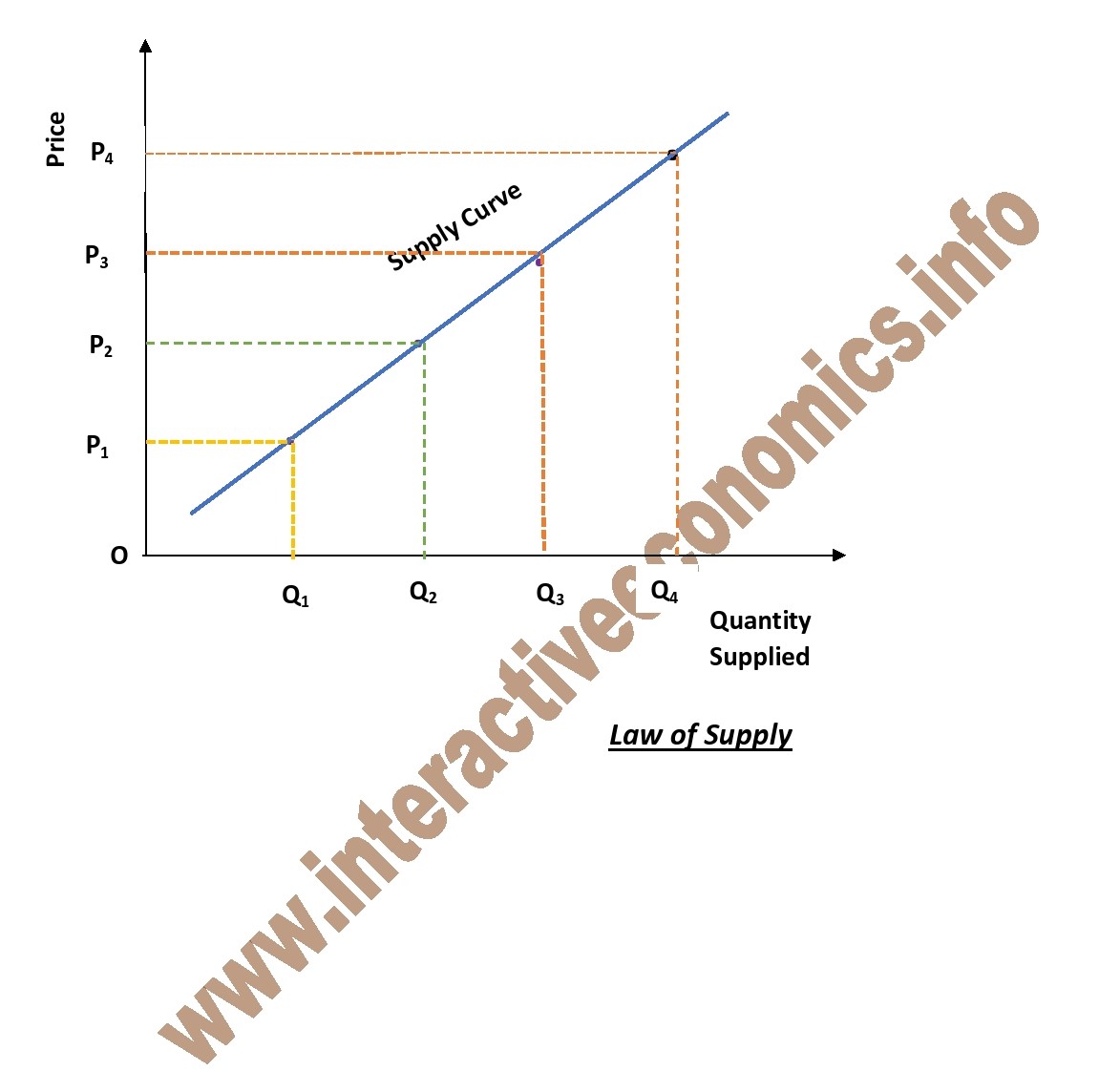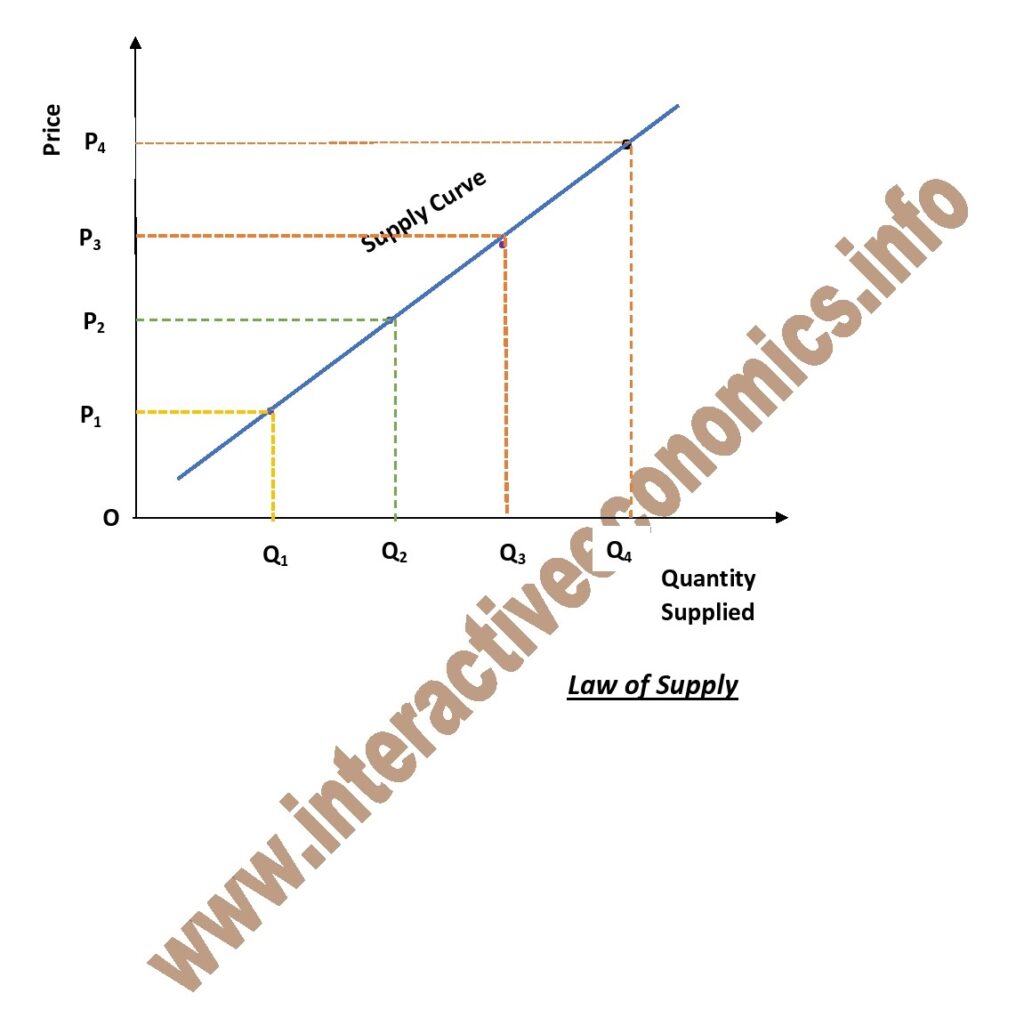
Law of Supply
The law of supply is a microeconomic law that states, with all other things being equal, that if the price or service rises, producers will offer more of those goods or services, and vice versa. According to the law of supply, suppliers will try to maximise their earnings when the price of the product rises by offering more products for sale. The supply curve in the graph below, which has an increasing slope, represents the law of supply. On the supply curve, there are points A, B, and C. Quantity provided (Q) and price are directly correlated at each point on the curve (P). Therefore, at point A, Q1will represent the amount supplied and P1will represent the price, and so forth. The increased slope of the supply curve results from suppliers’ increasing ability to decide how much of their products to supply and subsequently market. The supply that sellers bring to the market, however, is fixed at any given moment, and sellers must simply decide whether to sell or keep their stock from a sale. Consumer demand determines the price, and sellers may only charge what the market will bear. Consumer demand will eventually increase, that will drive up the price. As a result, suppliers may decide to allocate additional resources to production (or new suppliers may enter the market), increasing the amount provided. In a competitive market, demand ultimately determines price; a supplier’s reaction to the price they may anticipate receiving determines the quantity supplied.

One of the most basic ideas in economics is the law of supply. It explains how market economies distribute resources and set prices for products and services by combining the law of demand.
e.g.
The impact of price fluctuations on producer behaviour may be summed up by the law of supply. For instance, if the cost of video gaming consoles rises, a firm produces even more them. If video game prices fall, the opposite is true. If the price is 1000 Rs per system, the firm might sell 1 million, but if it goes up to 1200 Rs. per system, they might sell 1.5 million. Consider how gas prices operate to better clarify this idea. Building new oil refineries; buying more pipelines and oil tankers to transport oil to plants where it can be refined into fuel, opening more petrol stations; or extending the hours of existing petrol stations are just a few of the actions that profit-seeking entrepreneurs are encouraged to take when the price of fuel increases.
Key points:
1) According to the law of supply, suppliers will increase their supply to the market if the price is greater.
2) Firms will produce more of a good or service when they estimate paying a greater price for it because they want to raise their income.
3) A supply curve with an upward slope may be used to represent supply in a market and indicate how the quantity provided will react to different prices over time.
Limitations/Exceptions of law of Supply:
The following are some of the limitations/ exceptions to the law of supply
(1) Monopoly:
The law of supply may not apply if a small number of producers dominate the market’s supply. For instance, even though the price of the goods is higher, a monopoly (single seller) may not always give a larger amount supplied. The monopolist is able to handle the market, which enables it to determine the market price based on consumer demand.
(2) Competition:
Due to increased rivalry, other market structures, such as an oligopoly and monopolistic competition, may be able to attract more customers at lower prices, flouting the rule of supply.
(3) Price expectation of seller:
Even though the price level is extremely low, the seller will attempt to sell more if he anticipates that the price of the product will decline in the near future. On the other hand, even if the price level is high, the seller will not make any more sales if he anticipates a future increase in the price of the product. It goes against the law of supply.
(4) Auction Sale:
According to the law of supply, supply quantity rises when prices rise and vice versa. However, in the case of an auction sale, this law is not applicable. An auction sale is held when a seller is in a dire financial situation and needs money now.
(5) Perishable goods:
Perishable commodities are those that have a very short life span and thereafter become unusable. Whatever the cost, those commodities must be made available on the market at the appropriate time. As a result, the seller is prepared to accept any offer to buy his products. Additionally, it violates the law of supply.
(6) Stock clearance sale:
When a seller needs to get rid of old stock so that it makes room for new items, he might offer a sizeable quantity of items at a steep discount. Additionally, it violates the law of supply.
(7) Change in firm:
It is possible that the seller intends to close the current firm and start a brand new one. As a result, the seller may choose to reduce the price of his items when the current firm is about to close. Therefore, the rule of supply is not being observed here either.
( 8 ) Fear of being out of fashion:
As it is well known, factors influencing the quantity of a product supplied include fashion, consumer likings, technology, and time. The law of supply is also broken when a vendor sells more products at a reduced price because he believes they will soon become obsolete.
(9) Quantity Limiting Legislation:
Where the state has imposed restrictions on the amount of the good to be supplied or the price cap at which the good is to be sold in the market, suppliers cannot offer to sell bigger quantities at higher prices.
(10) Immediate need for money:
There may come a time when the seller needs money right now. In this case, he might even supply the products on the market for a lower price.
(11) Natural calamity:
If production is hampered due to a natural disaster, then supply doesn’t go up in spite of an increase in price.
(12) Seasonal product:
Despite price reductions, supply does not fall for seasonal products.
(13) Increase in wages:
Due to a laborer’s excess income, wage rate increases might occasionally result in a reduction in the work force. As a result, the law of supply does not apply.
(14) Agricultural Products:
Even when the prices are higher, the supply cannot expand beyond a certain point since the producer is unable to offer bigger quantities because the output of agricultural products cannot be enhanced past a certain point.
(15) Economic Slow-down:
Firms go through several stages, and suppliers must adjust to these changes in the business environment. Due to the potential disadvantage of incremental pricing during periods of weak economic growth, firms may choose to sell items even in the absence of price increases in order to cover costs. Therefore, the law of supply does not apply in this situation either.